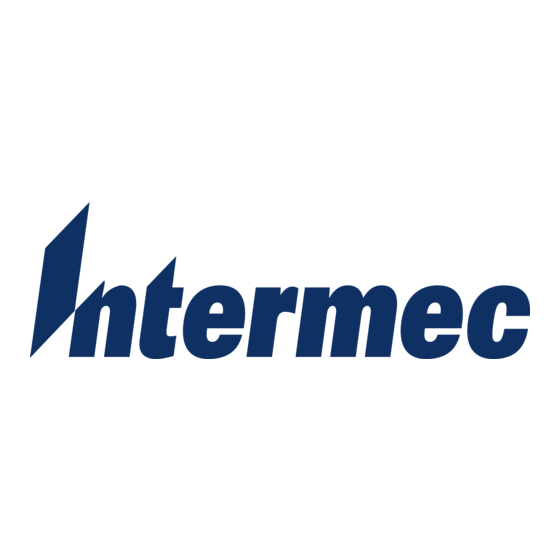
Table of Contents
Advertisement
Quick Links
Advertisement
Table of Contents

Subscribe to Our Youtube Channel
Summary of Contents for Intermec ITRF24501 PRELIMINARY EDITION
- Page 1 Quick Start Guide PRELIMINARY EDITION 28--MAR--02 164. "# 4A=@AH...
-
Page 2: Packing List
Check to ensure that you receive these items: Intermec R R R R 2450 Fixed Reader Model Number: ITRF24501 (part number country dependent) -
Page 3: Host Communication
ITRF24501 Reader Quick Start Guide Host Communication Host communication comes through the 9-pin female D-sub connector. Both RS-232 and RS-422 standards are supported as ordered from the factory or service center. Table 1-1 RS-232 Connections Pin Number Definition Serial Data from the Fixed Reader to the host Serial Data to the Fixed Reader from the host Ground CTS (Clear to Send) to the Fixed Reader from the... -
Page 4: Power Requirements
ITRF24501 Reader Quick Start Guide Power Requirements Power comes in from 8 to 10 volts DC. The Fixed Reader uses less than 2 amps. Intermec supplies 9 volts DC at 2.4 amps from Intermec power supply, #351-066-001. User I/O A general purpose I/O (Input/Output) connector provides signal lines in and out of the reader allowing monitoring and/or con- trol of external devices or functions. - Page 5 ITRF24501 Reader Quick Start Guide climb higher as the sink current increases. There is no protec- tion on this. You need to ensure that their load won’t require the reader to sink more than 50 mA. Input signals should be 0 to +1.5 volt for a low input and +3.5 to +5 volts for a high input.
- Page 6 ITRF24501 Reader Quick Start Guide Connecting and Getting Started WARNING: FCC regulations limit exposure to radiofrequency (RF) radiation. To comply with these regulations, operators of this device must maintain a distance of at least 20 cm. (8 inches) from the cover on the antenna assembly (The cover on the antenna is the dome shaped surface).
- Page 7 ITRF24501 Reader Quick Start Guide Antenna Installation Ensure that you read the above warning before installing the antennas and using your Reader product. Reader to antenna cable Mounting bracket Back view Front view 1. Review the locations where the Reader products need in- tegrated.
- Page 8 ITRF24501 Reader Quick Start Guide The following illustration is an example of a typical Reader installation. EXAMPLE: Two Product Line Conveyers, showing two antennas on each line. Two antennas in a crossing pattern provide angular diversity to improve read capability when tag orientation is unknown.
- Page 9 ITRF24501 Reader Quick Start Guide Connecting the Antenna to the Reader 1. Connect the antenna cable to a port. 2. Connect an SMA reverse--sex SMA terminator (Intermec p/n 345-004-001) to any port that does not have an anten- na attached.
- Page 10 ITRF24501 Reader Quick Start Guide 5. Review the front panel LEDs to become familiar with the status indications you will receive from your Reader. LEDs (left to right) Auxiliary I/O connector RS-232 or RS-422 port Power supply jack I (ON) O (OFF) switch Meaning LED 0 Reader has power is initialized and ready.
-
Page 11: Troubleshooting
425--356--1799 (elsewhere). Diagnostic PENNRFID.EXE Utility Should your Reader fail to read tags, download the test utility from the Intermec web site (http://www.intermec.com). This utility PENNRFID.EXE is a self-extracting zip file that includes installation instructions and a test utility to check the operation of the Reader on a laptop or desktop computer. -
Page 12: Performance Specifications
ITRF24501 Reader Quick Start Guide Performance Specifications Dependent upon operating conditions and demands expected. If used in a normal office environment with good read conditions, you could expect to read up to 30 tags per second. Tags located too far away or in poor locations, with respect to interfering objects, provides poor results. - Page 13 ITRF24501 Reader Quick Start Guide Table 1-5 (Continued) ITRF24501 Reader Specification Criteria Range Vibration 1.0 GRMS. 10 to 500 Hz in three axis Channel switching 30 uS (TX on a channel, to TX on any other channel) Frequency stability --50 to +50 PPM Transmitter power output 900 mW(typical) 1000 (max.) mW @ connector.
- Page 14 ITRF24501 Reader Quick Start Guide Corporate Headquarters 6001 36th Avenue West Everett, Washington 98203 tel 425.348.2600 fax 425.355.9551 www.intermec.com ITRF24501 Reader, Quick Start Guide-March, 2002 *962054051* 962054051 REV A...


Need help?
Do you have a question about the ITRF24501 PRELIMINARY EDITION and is the answer not in the manual?
Questions and answers